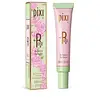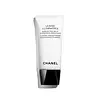What's inside
What's inside
 Key Ingredients
Key Ingredients

 Benefits
Benefits

 Concerns
Concerns

 Ingredients Side-by-side
Ingredients Side-by-side

Water
Skin ConditioningPropanediol
SolventEthylhexyl Palmitate
EmollientMica
Cosmetic ColorantDiphenylsiloxy Phenyl Trimethicone
Skin ConditioningDiisostearyl Malate
EmollientSteareth-21
CleansingSynthetic Fluorphlogopite
Glyceryl Stearate Se
EmulsifyingEthylhexyl Salicylate
UV AbsorberSqualane
EmollientPanthenol
Skin ConditioningRosa Damascena Flower Water
MaskingAscorbyl Palmitate
AntioxidantTocopheryl Acetate
AntioxidantRosa Rubiginosa Seed Oil
EmollientSodium Hyaluronate
HumectantCeramide NP
Skin ConditioningPelargonium Graveolens Oil
MaskingHydroxyethyl Acrylate/Sodium Acryloyldimethyl Taurate Copolymer
Emulsion StabilisingPolysorbate 20
EmulsifyingSorbitan Isostearate
EmulsifyingCetyl Dimethicone
EmollientHydroxyacetophenone
AntioxidantSteareth-2
EmulsifyingAcrylates/C10-30 Alkyl Acrylate Crosspolymer
Emulsion StabilisingSodium Hydroxide
BufferingPhenoxyethanol
PreservativeCitronellol
PerfumingGeraniol
PerfumingTin Oxide
AbrasiveCI 77891
Cosmetic ColorantCI 77491
Cosmetic ColorantWater, Propanediol, Ethylhexyl Palmitate, Mica, Diphenylsiloxy Phenyl Trimethicone, Diisostearyl Malate, Steareth-21, Synthetic Fluorphlogopite, Glyceryl Stearate Se, Ethylhexyl Salicylate, Squalane, Panthenol, Rosa Damascena Flower Water, Ascorbyl Palmitate, Tocopheryl Acetate, Rosa Rubiginosa Seed Oil, Sodium Hyaluronate, Ceramide NP, Pelargonium Graveolens Oil, Hydroxyethyl Acrylate/Sodium Acryloyldimethyl Taurate Copolymer, Polysorbate 20, Sorbitan Isostearate, Cetyl Dimethicone, Hydroxyacetophenone, Steareth-2, Acrylates/C10-30 Alkyl Acrylate Crosspolymer, Sodium Hydroxide, Phenoxyethanol, Citronellol, Geraniol, Tin Oxide, CI 77891, CI 77491
Water
Skin ConditioningGlycerin
HumectantAlcohol
AntimicrobialCamellia Oleifera Seed Oil
Skin ConditioningCalcium Sodium Borosilicate
Ammonium Acryloyldimethyltaurate/Vp Copolymer
Caesalpinia Spinosa Fruit Extract
Skin ProtectingKappaphycus Alvarezii Extract
Skin ConditioningMaris Aqua
HumectantSynthetic Fluorphlogopite
Butylene Glycol
Humectant1,2-Hexanediol
Skin ConditioningCaprylyl Glycol
EmollientAcrylates/C10-30 Alkyl Acrylate Crosspolymer
Emulsion StabilisingArginine
MaskingParfum
MaskingPotassium Sorbate
PreservativeTocopherol
AntioxidantSodium Hyaluronate
HumectantSilica
AbrasivePhormidium Persicinum Extract
AntioxidantTin Oxide
AbrasiveCitric Acid
BufferingCI 77007
Cosmetic ColorantCI 77491
Cosmetic ColorantCI 77492
Cosmetic ColorantCI 77499
Cosmetic ColorantCI 77891
Cosmetic ColorantWater, Glycerin, Alcohol, Camellia Oleifera Seed Oil, Calcium Sodium Borosilicate, Ammonium Acryloyldimethyltaurate/Vp Copolymer, Caesalpinia Spinosa Fruit Extract, Kappaphycus Alvarezii Extract, Maris Aqua, Synthetic Fluorphlogopite, Butylene Glycol, 1,2-Hexanediol, Caprylyl Glycol, Acrylates/C10-30 Alkyl Acrylate Crosspolymer, Arginine, Parfum, Potassium Sorbate, Tocopherol, Sodium Hyaluronate, Silica, Phormidium Persicinum Extract, Tin Oxide, Citric Acid, CI 77007, CI 77491, CI 77492, CI 77499, CI 77891
Alternatives
Ingredients Explained
These ingredients are found in both products.
Ingredients higher up in an ingredient list are typically present in a larger amount.
Acrylates/C10-30 Alkyl Acrylate Crosspolymer is a synthetic polymer. It is used to thicken and improve the texture of products. Due to its properties, it can prevent water and oil ingredients from separating.
Ci 77491 is also hydrated iron III oxide. It's sole purpose is to give a red/pink hue to products.
Iron III oxides are classified as inorganic chemicals for coloring.
Synthetically created Ci 77491 is considered safer than those naturally found. This is because the synthetically created version may contain less impurities. Iron oxides are generally non-toxic and non-allergenic.
Learn more about CI 77491Ci 77891 is a white pigment from Titanium dioxide. It is naturally found in minerals such as rutile and ilmenite.
It's main function is to add a white color to cosmetics. It can also be mixed with other colors to create different shades.
Ci 77891 is commonly found in sunscreens due to its ability to block UV rays.
Learn more about CI 77891Sodium Hyaluronate is hyaluronic acid's salt form. It is commonly derived from the sodium salt of hyaluronic acid.
Like hyaluronic acid, it is great at holding water and acts as a humectant. This makes it a great skin hydrating ingredient.
Sodium Hyaluronate is naturally occurring in our bodies and is mostly found in eye fluid and joints.
These are some other common types of Hyaluronic Acid:
Learn more about Sodium HyaluronateSynthetic Fluorphlogopite is the synthethic version of mica. It consists of fluorine, aluminum and silicate.
Synthetic Fluorphlogopite is used to add volume to products.
It is considered non-irritating on the skin.
Learn more about Synthetic FluorphlogopiteTin Oxide is an inorganic oxide used to add opacity and volume to a product. In nature, it is already found in mineral form. The main ore of tin is an opaque and shiny mineral called casseterite.
Tin Oxide helps remove translucency in a product, or make it more opaque. Besides adding opacity, tin oxide is used for bulking to add volume.
Water. It's the most common cosmetic ingredient of all. You'll usually see it at the top of ingredient lists, meaning that it makes up the largest part of the product.
So why is it so popular? Water most often acts as a solvent - this means that it helps dissolve other ingredients into the formulation.
You'll also recognize water as that liquid we all need to stay alive. If you see this, drink a glass of water. Stay hydrated!
Learn more about Water